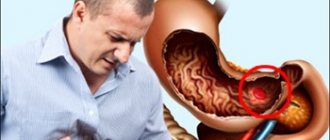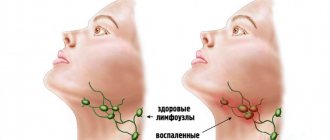Inguinal hernia: symptoms, causes and treatment options
An inguinal hernia in men is a disease in which the walls of the abdominal cavity weaken and cannot hold the internal organs in place. In this case, an inguinal-scrotal hernia appears due to weakening of the inguinal muscles. As a result, protrusion of the organ under the skin is visible. Hernia occurs quite often, especially in older men.
The main factor in its occurrence is serious and regular stress on the abdominal cavity. In order to recognize the disease in time and prevent the development of complications, you need to know its symptoms. And for clarity, you can see what an inguinal hernia in men is in the photo. They will help present the overall picture of the disease.
Causes
An inguinal hernia can occur for a variety of reasons. The following factors are identified that can contribute to the appearance of this disease in men:
- Frequent (chronic) cough, which will put a lot of strain and pressure on weakened areas of the abdomen, which in turn can give rise to the formation of an inguinal hernia.
- A person's hereditary predisposition to an inguinal hernia is revealed in the anatomical weakness of the abdominal muscle tissue.
- Some diseases of the intestinal system can increase intra-abdominal pressure, especially when they cause constant constipation in the sick person.
- Excessive physical activity, which puts strong pressure on the abdominal cavity (and increases intra-abdominal pressure itself). Lifting heavy objects, holding something suspended, and carrying heavy things in front of you is considered especially dangerous.
- Previously suffered injuries to the groin area, which caused a sharp weakening of ligaments and muscles.
- Sudden weight loss leads to the formation of empty volumes in the human peritoneum, which can push outward into the abdominal cavity.
- Excess weight can put excessive stress on internal organs, which increases a person’s tendency to develop an inguinal hernia.
As can be understood from the above, several factors can contribute to the development of an inguinal hernia in men, but the most common cause of this disease is lifting heavy objects. It is most quickly capable of leading to an acute condition in a person, in which he will require immediate treatment.
Pathology
From congenital anomalies and acquired defects in the structure of P. o. the most common are hernias (see).
Of the inflammatory processes, a furuncle (see), carbuncle (see), hidradenitis (see), lymphadenitis of superficial lymph nodes (see Lymphadenitis), which develops as a result of the transfer of infection from inflammatory foci localized in hl., are often observed. arr. on the skin of the external genitalia and the anteromedial surface of the thigh, sometimes the lower leg and foot. Specific inguinal lymphadenitis is characteristic of primary syphilis (see) and chancre (see). With chancroid, purulent melting of lymph nodes often occurs with the formation of a typical ulcer in the groin. In P. o. sometimes cold, draining ulcers that occur with tuberculous spondylitis descend (see).
Classification
Depending on the origin of the hernial sac, hernias are:
- Acquired - occur mainly in adults who experience severe physical exertion. They are both straight and oblique.
- Congenital - occur when the vaginal process of the peritoneum does not grow, when the testicles descend into the scrotum before birth. They are only oblique.
According to the anatomical classification, hernias are of the following types:
- Direct inguinal hernia is always acquired, never passes through the spermatic cord and does not descend into the scrotum; these are the signs that distinguish it from an indirect inguinal hernia. This hernia is very rarely strangulated. The sizes are usually not very large, on average 5-10 cm;
- Oblique PG - characterized by the passage of the hernial sac as part of the spermatic cord with the subsequent appearance of a protrusion under the skin of the groin area, and in advanced cases, in the scrotum. Has a tendency to infringe. Sizes vary from 4-5 cm to giant ones - 30-40 cm;
- Supravesical PG - occurs when there is weakness in the anatomical structures located immediately above the pubic bone. The protrusion is usually not very large;
- Sliding hernia – already from the name it can be assumed that this type of hernia is characterized by incomplete entry of the organ into the hernial sac, but only by one of its walls. Often, only part of the bladder and cecum ends up in the hernial sac. That is why, with this type of hernia, some difficulties arise when suturing the hernial sac during surgery;
- Combined inguinal hernia - with this type of hernia, the patient simultaneously experiences direct and oblique inguinal hernias, very rarely they are joined by a supravesical hernia.
Another important clinical classification on which the choice of treatment depends:
- Irreversible PG - occurs when there is a long-term presence of a hernia, when the hernial sac is connected by adhesions to the subcutaneous fatty tissue. In this case, it is not possible to reduce the hernia into the abdominal cavity, but its contents are not tense and may slightly decrease or increase;
- Reducible hernia - characterized by independent or manual reduction of the contents of the hernia into the abdominal cavity. Usually these are small hernias and at the initial stage of development, when adhesions between the tissues have not yet formed;
- Strangulated hernia - if it is strangulated, it is impossible, even with external help, to reduce the contents of the hernia into the abdominal cavity. In this case, the hernial sac is tense and painful.
You can determine whether an inguinal hernia is strangulated or not by performing a simple task - holding the hernia with your hand, you need to cough several times. If at the same time the hernial protrusion increases and decreases, then the hernia is reducible. Otherwise, if, when coughing, the protrusion does not change its size and continues to hurt, it is most likely that the hernia is strangulated!
Femoral hernia on ultrasound
To view the femoral hernia, the probe is placed below the inguinal ligament (position 4). A femoral hernia emerges medially from the femoral vein. Please note that during the Valsalva maneuver, the femoral vein dilates.
Important!!! An enlarged Pirogov-Rosenmuller lymph node, which is located under the inguinal ligament, is sometimes mistaken for an inguinal hernia. It appears to be a homogeneous structure of medium echogenicity with smooth, clear contours.
| Photo. A 30-year-old woman with a right-sided femoral hernia. A - At rest, the hernia is not determined: femoral artery (A), femoral vein (V), superior branch of the pubic bone (curved arrow). B — After the Valsalva maneuver, a femoral hernia is determined medially from the femoral vein (V). | ||
| Photo. At rest (A) the hernia is not visible medially to the femoral vein (FV), but after the Valsalva maneuver (B) a femoral hernia appears (arrows). | ||
| Photo. On the transverse (A) and longitudinal sections (B) medially from the femoral vein (FV), hyperechoic fat (arrow) is determined - this is a femoral hernia. | ||
Symptoms
In men, the symptoms of an acquired inguinal hernia (see photo) are as follows:
- The formation can be straightened with regular pressure, and a characteristic rumbling sound can be heard.
- In a lying position, the protrusion usually either levels out or greatly decreases in size, and vice versa, in an upright position it increases and appears again.
- In the reduced state of the hernia, you can easily feel the enlarged inguinal ring through the skin.
- When the hernial sac descends into the scrotum, the corresponding half of the scrotum increases in size.
- With strong coughing, straining, or sneezing, the hernia increases in size and becomes tense; if you put your hand on it, you can easily feel it.
With a small inguinal hernia, there are no longer any symptoms that bother the patient. But with a significant increase in protrusion, the following ailments may appear:
- Pain in the lower back, lower abdomen - this occurs due to compression of other organs and intestines.
- Aching, prolonged pain in the area of the hernial formation.
- Other signs of indigestion, such as bloating, loud rumbling.
- Constipation, this is also caused by compression of the intestinal loops in the hernial sac.
- In rare cases, if part of the bladder gets into a hernial formation, problems with urination may occur.
The symptoms of an inguinal hernia are quite obvious upon visual examination; the formation has a dense elastic consistency and is easily palpable on its own. It can be round, and if the hernial sac descends into the scrotum, then the protrusion has an elongated shape. As a rule, with a genetic predisposition, the body’s tendency to develop a hernia, a hernial protrusion may occur after lifting weights and intense physical activity.
A hernia appeared in the groin. What to do?
You or your relative, father, husband, friend, colleague or just a loved one has an inguinal hernia. It always appears at the wrong time and unexpectedly for its new owner, sometimes on both sides at once (bilateral). The process of herniation begins. The scenario and first signs of the appearance of a hernia vary. Anything can happen against the background of complete well-being and good general condition. Unpleasant pulling sensations in the lower abdomen appear and disturb, or after strong physical activity (static tension, heavy lifting, repairs, sports) a sharp pain occurs in the groin. Unpleasant sensations and pain may subside and go away on their own, but then a characteristic tumor-like hernial formation (bulging, bulging) of an oval or round shape is discovered in the groin area.
Consultation with a surgeon, candidate of medical sciences
Make an initial appointment in Moscow by phone
An inguinal hernia comes in different sizes (from a pea or larger) and can enlarge with coughing, sneezing, straining and physical activity. Pain, discomfort and discomfort are usually periodic. The hernia is mobile, reducible, and over time, it can begin to descend into the scrotum, turning from just inguinal to inguinal-scrotal. In addition to pain and discomfort, there are often dysuric phenomena (impaired urination - frequent, difficult or involuntary, urinary retention, pain and discomfort in the urethra). Periodic chronic constipation and/or bloating may be a concern. If your close relatives (father, grandfather, great-grandfather and others) had a similar pathology, then the likelihood of it happening to you and your children is very high. The process, location and age at which the formation appears in the groin may be similar. The symptoms are often the same.
A hernia has appeared. It would seem that there is nothing wrong and you can continue to live with her. Especially if it is small in size and practically does not bother you. Yes, there is some discomfort, there are inconveniences, but it seems that you can put up with it. In this situation, some choose the “ostrich” tactic and try to avoid the problem and not pay attention to it. Others enter a mode of observation and watchful waiting. You know, indeed, you can live like this for some time, but you need to take into account that the hernia carrier’s quality of life will suffer and decrease. Taking this factor into account, you need to decide what to do next.
If nothing is done, the hernial protrusion, as a rule, gradually increases in size and becomes more and more disturbing. More and more new symptoms appear that make it difficult to live peacefully. The discomfort is growing. But most importantly, there is always a danger of complications (strangulation, coprostasis and others). An inguinal hernia is like a “bomb” in your pocket, which can suddenly explode at any moment (both day and night) (complicated - pinched). And then she will have to be operated on as an emergency, which means that the likelihood of postoperative complications increases many times over, even after a well-performed surgical intervention. Hernioplasty (surgery) in such a situation will be less reliable, and the likelihood of relapse is very high.
When an injury occurs, it will be a great success if there is a good hospital and a qualified surgeon nearby. And if not? What if you are far from home? Business trip? On a rest? Fishing? Abroad? In such a situation, everything is left to chance. You are taking a risk... The consequences can be unpredictable and sometimes disastrous. The hernia limits freedom of movement. You need to constantly remember it. Among other things, the condition of a person with a hernia negatively affects not only him, but also affects his family, relatives and friends. A man can quietly plunge into prolonged depression and frustration. It's no secret that behind the outer brutal shell, imperturbable character and iron will often hide fears that are not voiced even to oneself. The stronger sex can solve the most difficult problems, be a stone wall for their loved ones and friends, stand to death, but men also need help and support. Often, hernia carriers do not want to talk about their problems and show their weaknesses. Sometimes the mere mention of a visit to the doctor or the need for surgery puts you into a stupor. It seems that it is easier to die than to solve this problem.
No matter how difficult and scary it may be, it is necessary to face this problem head on. And here only really close people whom a man trusts can help. These are usually parents, wives, children or friends. We need to walk this path together, step by step. The path from the appearance of a hernia to surgery and successful rehabilitation. To make the right decisions, you need to find answers to the many questions that arise with your family and friends.
What is an inguinal hernia? How does she look? What are its reasons? Why did it appear specifically for me? What health risks does an inguinal hernia pose? Who is treating? Where to contact? How to cure a hernia? Is it possible not to contact a surgeon? Is it possible to do without surgical treatment (not undergo surgery)? Is it possible to cure a hernia with folk, home or alternative remedies? Is it dangerous not to have surgery? If I have surgery, where can I do it? Where is the best place to do this operation? How long does the operation take? Does it hurt? What anesthesia or anesthesia is used to perform the operation? What surgical procedures are used to remove an inguinal hernia? What is the best operation to do? Open cavity or laparoscopic? What are the differences between surgical interventions for inguinal hernia? Is it possible to cut out hernias from both sides at once? What is needed before surgery? What examinations are needed? How much does surgery to remove an inguinal hernia cost? Cost of surgery (hernia repair)? What are the complications? What to do if there is a complication? What kind of rehabilitation is necessary after surgery? For how long is sick leave issued? What to do? And many, many other very diverse questions...
No one prepares to answer these questions from childhood, and many will not even need it in life. But if you are faced with such a problem, then you cannot do without collecting information. You should not complain about fate, rely on miracles or traditional healers. You need to learn as much as possible and immediately and consistently act. If you go to any forum on inguinal hernias, to the questions and answers section or frequently asked questions (FAQ, Q&A), and type reviews in search engines, you will see a lot of different opinions and advice. Sometimes they can be contradictory or even mutually exclusive. In order to act, you need information and knowledge from different sources. Read, analyze, think, ask and make decisions, only for you. We will try to help you, tell you in detail about inguinal hernias in men and answer your questions...
Strangulated hernia
A strangulated inguinal hernia is accompanied by the following symptoms:
- weakness, tachycardia;
- nausea, vomiting;
- bloating, lack of stool;
- negative reaction to a cough impulse; when coughing, placing a finger on the inguinal ring, shocks are usually felt; if the hernia is strangulated, the impulse is not transmitted;
- the hernia stops being reduced;
- the hernial sac is very tense;
- sharp, acute pain in the hernia area and in the abdomen.
A strangulated inguinal hernia is a very dangerous complication, so medical care should be provided as soon as possible. The operation must be performed as quickly as possible, since serious complications may develop, such as:
- Necrosis is the necrosis of parts of the intestinal loops or omentum that have fallen into the hernial sac.
- Peritonitis - with prolonged strangulation of the groin hernia, inflammation of the abdominal cavity develops.
At the same time, irreducible and large hernias, even without complications, cause discomfort to patients: they limit their activity and are accompanied by unpleasant symptoms.
Incarceration of the spermatic cord on ultrasound
As a complication of an inguinal hernia, strangulation of the spermatic cord can occur. Compression of the vascular pedicle in the aponeurotic ring of the hernial orifice leads to ischemia and infarction. The disease occurs acutely and is accompanied by severe pain. The testicle increases in size, becomes red, swollen, and firm to the touch. On ultrasound, the tunica albuginea is thickened and swollen, the testicle is hypoechoic and heterogeneous. With CDK, blood flow in strangulated organs is sharply reduced, and with necrosis, avascular zones appear.
Take care of yourself, Your Diagnosticer !
Tags: hernia lectures ultrasound
Treatment of inguinal hernia in men
The only treatment for inguinal hernia in men is surgery. During the operation, the doctor excises the hernial sac and performs plastic surgery of the hernial orifice, which prevents further relapses of the disease. Plastic surgery of the hernial orifice can be performed either using an aponeurosis (tension technique) or using a special mesh prosthesis (non-tension technique).
In most cases, removal of an inguinal hernia in men is performed with the subsequent use of a polypropylene mesh. It is installed in the hernial orifice and fixed. Subsequently, connective tissue fibers grow through its cells and form a reliable barrier for the abdominal organs on the way to the inguinal canal. Using this technique significantly reduces the likelihood of recurrence of the disease.
Surgeries for inguinal hernia in men can be performed either in the traditional open way with a skin incision, or laparoscopically - through a small puncture.
Treatment
Pre-hospital assistance
The appearance of sharp pain in the groin indicates the possible presence of dangerous pathologies: the passage of stones due to urolithiasis, strangulated hernia or acute appendicitis. In these cases, an immediate call to an ambulance is required. Self-administration of painkillers is not recommended, as it can distort the symptoms and complicate the diagnosis. Before the doctor arrives, the man needs to be kept at rest by being placed in a comfortable position.
Conservative therapy
Therapeutic tactics are determined by the cause of pain in the groin. The following treatment methods can be used:
- Painkillers
. To reduce the severity of pain, analgesics and NSAIDs are used in short courses. Medicines are taken only as prescribed by a doctor. - Antibacterial therapy
. Men with nonspecific inflammatory processes are initially prescribed a broad-spectrum antibiotic. Then the drug is replaced taking into account antibiotic sensitivity. For mycoplasmosis and ureaplasmosis, fluoroquinolones, macrolides and tetracyclines are used, for gonorrhea - cefixime, ceftriaxone, ciprofloxacin. - Immunomodulators
. To provoke indolent sexually transmitted infections, suppositories with immunostimulants may be indicated. In inflammatory processes against the background of a decrease in the body's defenses, medications are needed to correct the immune system. - Other medicines
. Taking into account the genesis of the pathology, antispasmodics, diuretics, hormonal and desensitizing agents may be required. For pain of orthopedic etiology that is resistant to drug therapy, hormonal blockades are possible. - Physiotherapy
. The list of physiotherapeutic procedures includes electrophoresis, Bernard currents, magnetic therapy, laser therapy, ultrasound. For some andrological diseases, microenemas and prostate massage are effective. For orthopedic diseases, exercise therapy, massage, and shock wave therapy are recommended.
Surgery
Men with groin pain undergo the following surgical interventions:
- Inguinal hernia
: hernioplasty with own tissues or using a mesh prosthesis, Lichtenstein operation, elimination of the inguinal canal. - Andrological diseases
: Marmara, Palomo and Ivanissevich operations, varicocele embolization, funiculocele excision, epididymotomy, removal of prostate adenoma, spermatic cord torsion operations, orchiectomy. - Urinary tract pathologies
: contact or extracorporeal lithotripsy, pyelolithotomy, ureterolithotomy, ureteral stenting, ureteroplasty, nephrectomy. - Appendicitis
: open or laparoscopic appendectomy. - Orthopedic diseases
: operations for ARS syndrome, osteosynthesis of a femoral neck fracture, hip replacement.
Laparoscopic surgery for inguinal hernia
Laparoscopic technology allows special manipulators to enter the patient's abdominal cavity through small punctures on the anterior abdominal wall. The advantage of the operation is that there are no scars left after it, and minor damage to the tissues is caused during the procedure.
- At the initial stage, the patient is given anesthesia. The intervention is performed under general anesthesia (anesthesia).
- Carbon dioxide is pumped into the abdominal cavity, due to which the anterior abdominal wall is raised like a dome, and conditions are created for surgeons to work.
- The hernial sac with its contents returns back to the abdominal cavity.
- A mesh is sutured from the inside to the abdominal wall. As a result of this, it more effectively holds the abdominal organs and prevents them from extending beyond its limits. Gradually it grows and is securely fixed in its place.
Due to a number of advantages, laparoscopic hernia treatment methods are gradually gaining popularity. However, if the protrusion is large, then surgeons prefer to work using traditional methods, since it is technically easier to perform the intervention. Therefore, it is necessary to contact doctors for help as early as possible and receive treatment using the most modern methods.
How long do you need to stay in hospital? Usually, after laparoscopy, a man can go home within 1 day after the operation, if no complications arise.
Complications after surgery
The most common consequences after surgery are:
- Seams coming apart.
- Hematomas. To prevent them, ice is applied immediately after surgery.
- Infection and suppuration of the wound. To avoid this, a course of antibiotics is prescribed.
- Dropsy of the testicles. Develops due to damage to the membranes of the testicle. A symptom of this complication is an enlargement of the scrotum on one or both sides. It can only be treated surgically.
- Damage to the spermatic cord. It occurs due to the fault of the doctor and is associated with the structural features of the inguinal canal. The spermatic cord passes close to the hernial sac, so if the doctor is insufficiently qualified, it can be damaged. This complication can lead to infertility.
- Damage to the hip joint. Occurs in case of rough sutures.
- Relapse. Recurrence of a hernia most often occurs due to patient non-compliance with the regimen.
- Damage to blood vessels. This is also a rather serious complication, as it leads to testicular atrophy.
Even an operation to remove an inguinal hernia in men that is considered easy and safe can be accompanied by complications. Most often, they arise through the fault of the patient himself, due to violation of restrictions during the rehabilitation period. Sometimes complications arise due to the fault of the surgeon, or arise as a result of the individual characteristics of the body.
Preparing for planned surgery
Before carrying out a planned intervention, an examination by a surgeon and examination are required. This is necessary to clarify the diagnosis and make sure that you really have an inguinal hernia. Formations in the groin are different and there are many other diseases that may be similar to an inguinal hernia (femoral hernia, lipoma of the groin area, lymphadenitis, hydrocele - hydrocele of the testicular membranes, varicocele and others) and which need to be distinguished (differentiated). Treatment tactics for other pathologies are different. Examination and examination are necessary to exclude contraindications to surgical treatment. Before surgery, physical activity (heavy lifting) should be limited and overeating should be avoided. Chronic foci of infection must be sanitized (cured). If cough or constipation is present, appropriate treatment should be given. A few weeks before surgery, it is mandatory to stop smoking and drinking alcohol.
List of tests and examinations before planned surgery:
- Tests: complete blood count (CBC, finger prick), blood sugar, complete urine test (UCA), biochemical blood test (AST, ALT, total bilirubin, direct bilirubin, urea, creatinine, total protein), blood test (for HIV , hepatitis B, hepatitis C, syphilis), blood type, Rh factor
- ECG
- Fluorography (or chest x-ray)
Diet after hernia repair
A proper diet will speed up recovery. For the first few days, it is better to eat only liquid and pureed food in small portions. On day 4-5 you can go back to your normal diet.
You need to eat as many foods rich in protein and fiber as possible. The diet should include:
- lean boiled meat (chicken, beef);
- seasonal vegetables (raw or steamed);
- dairy products, especially cottage cheese;
- fruits and berries;
- various porridges (buckwheat, millet, oatmeal, pearl barley);
- Fish and seafood;
- nuts and dried fruits.
It is better to exclude alcohol and coffee from your diet, as well as smoking.
What are the options for treating an inguinal hernia without surgery?
Taking into account the pathogenesis of the disease, it is believed that treatment for inguinal hernias without surgery is impossible. It should be borne in mind that the bandage also does not cure, but only helps to keep a reducible inguinal hernia in men in the abdominal cavity.
According to some doctors, treating an inguinal hernia in men with physical exercise has no therapeutic effect. However, many experts advise using exercises to increase the strength of the abdominal muscles, but only while lying on your back or sitting.
For example, exercises such as:
- breathing with the stomach with a load (1-2 kg) on the abdominal wall;
- raising straight legs 30° relative to the horizontal position of the body;
- raising the shoulder girdle and shoulder blades from a horizontal position (with hands placed on head);
- squeezing a ball placed between the knees (lying on your back, with your knees bent), etc.
The most suitable yoga asanas for inguinal hernias are: uddiyana, pavanmuktasana, sarvangasana, etc. Uddiyana asana should be performed while sitting: exhale the air forcefully, “squeezing” it out of the lungs, drawing in the stomach as much as possible, hold for three seconds, and then take a deep breath through the nose. Repeat 5-6 times.
Diagnostics
Usually, it is not difficult for a urologist or surgeon to make a diagnosis after an initial examination and palpation. The doctor conducts functional tests: assesses the enlarged area of the scrotum while the patient lies, stands, and performs physical exercises.
Doctors additionally prescribe laboratory tests to assess the general condition of the body. To differentiate the pathology from testicular hyperplasia, tumors and other problems, specialists perform: ultrasound of the scrotum and ultrasound of the pelvic organs, radiography.
Other studies are possible, for example, cystography (the condition of the bladder is assessed), irrigoscopy (the structural changes in the intestines are checked).
Prevention
The disease can be prevented by avoiding excessive physical activity and lifting heavy weights. It is important to take care of the stable functioning of the gastrointestinal tract, because constipation provokes hernias. You need to lose excess weight and do physical therapy. You should strengthen your abdominal wall by performing abdominal exercises and “bicycle” exercises. Therapeutic gymnastics should be given at least 20-30 minutes a day.
It should be noted the importance of maintaining a competent diet. You need to eat often, but little by little, and no alcohol. Instead of fatty and spicy foods, flour and confectionery products, you need to eat vegetables, fish and meat, boiled or steamed.










